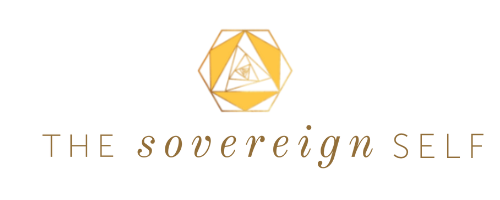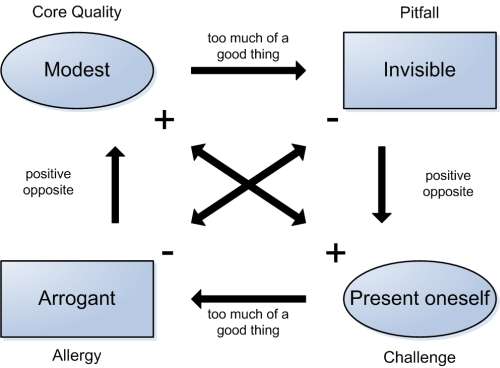We all have ‘core qualities’. Qualities that are so ingrained in our being, that we hardly notice them about ourselves. They come so natural to us that we really don’t register them as anything special. However, the people around us know exactly and these core qualities offer us a very authentic and powerful tool into more effective leadership and interpersonal connection.
In fact, knowing and understanding your core qualities turns them into leadership qualities to add to your tool box of authentic leadership. It offers great insight into what triggers you in others, and in your own pitfalls and challenges. It actually is a great tool for improving your leadership, and becoming a more effective leader.
Daniel Ofman developed a model, the Core Quality Quadrant, that helps explore your own core qualities, which also illuminates these other elements. His work creates understanding around ourselves and our relations with other people. When you understand the core quadrant of your quality, it is much clearer why you respond to others the way you do, and it is possible to leverage the power of your core qualities into leadership qualities.
Each Core Quadrant is comprised of 4 aspects:
the Core Quality itself
A core quality is a special strength, something you are really good at, or for which you are often praised by others. To you, it may be nothing special though: you probably believe anyone can do it. It is an inherent quality that can either be suppressed or developed.
Examples of typical core qualities are decisiveness, considerateness, carefulness, courage, orderliness and flexibility.
The Pitfall
A pitfall is ‘too much of a good thing’. The positive aspect of a core quality is the ‘over the top’-variety, which turns your strength into a weakness.
For example: helpful becomes meddling; careful becomes fussy; flexible becomes capricious.
In interaction with others: when you get annoyed by certain behavior, chances are that your experiencing someone behaving in the pitfall of what is actually their core quality. When you’re aware of this model, you can turn your irritation around by looking for the underlying core quality.
For example: someone who acts inflexible may have decisiveness as a core quality. Someone with an unyielding attitude may be a go-getter at the core.
the Challenge
The challenge is the positive opposite of a pitfall. When you’ve identified the negative, transformed behaviour (the pitfall), you can start looking for the challenge.
For example: in a nagging person, the positive opposite (the challenge) is patience (the core quality is decisiveness).
And: in a capricious person, the challenge is orderly behaviour (the core quality is flexibility).
The core quality and the challenge are complementary qualities. The goal is to find a balance between the two, so that you don’t go to the extreme (and thus your pitfall). For example: It is not necessary to become less decisive, but to develop more patience, resulting in some sort of ‘patient decisiveness’ which creates space for others to contribute, without turning into nagging.
Or: finding a balance between flexibility and orderliness.
the Allergy
The core qualities can also be used to identify potential conflicts with the people around you. People tend to be ‘allergic’ to too much of their own challenge in other people. The allergy is where someone is showing ‘too much of a good thing’ (your challenge). You can also see it as the negative opposite of the core quality.
For example: the negative opposite of the core quality decisiveness is passiveness. Too much patience (the challenge for a decisive person) may degenerate into passiveness.
The more you are confronted with your own allergy, the greater the risk that you fall into your pitfall. For example: the decisive individual starts nagging in response to too much passiveness in another person.
Leadership Qualities in relation to the core quadrant
- When you meet someone who shares your core quality
Most often, you’ll respect each other, but in certain circumstances, especially when under stress, both of you will turn to nagging. You can probably easily identify each other’s pitfalls. - When you meet your opposite
Meeting your opposite more often than not results in feelings of contempt, which is characteristic of a situation in which you are confronted with your allergy. This type of confrontation makes you vulnerable to your pitfall.
Awareness of this may help you to identify your pitfall and thus prevent this from happening. - People are usually allergic to the exaggerated version of what they themselves need most (their challenge). In other words, you can learn a lot from people you have a hard time dealing with.
- When you encounter someone whose behaviour is your allergy, you might be able to recognize this behaviour as the overstated version of the other person’s core quality. If you look at it from this perspective, you may be able to help the other person find the core quality behind that pitfall. If this succeeds, the core quality creates a perfect basis of cooperation with your own core quality.
YOUR JOURNEY
So after reading this, do you feel you would like help exploring your core qualities? We offer one-on-one executive coaching and love to work with people who are ready to really take ownership of who they are. Please read more about our offerings here.
ABOUT THE AUTHOR
Rosalie Puiman is the founder of The Sovereign Leader and the author of The Mindful Guide to Conflict Resolution. She works with executives and founding teams to bring forth effective, impactful and purpose-driven success.


